by Tom Gaylord
Writing as B.B. Pelletier
This report covers:
- Happy Memorial Day
- Bucket list
- Webley Mark I
- Webley Mark II Service
- One of the finest ever made
- Breech
- Sights
- Large rifle
- Stock
- What now?
Happy Memorial Day
Today is the day we remember all those who have fallen in defense of our nation. To all the veterans and to the families of those who have given their lives to protect our way of life I say, thank you!
Bucket list
The Webley Mark II Service air rifle is one that’s been on my bucket list for decades. I think I first learned about it in Smith’s Standard Encyclopedia of Gas, Air and Spring Guns of the World, by W.H.B. Smith. That would have been around 1977. I was living at Ft. Knox, Kentucky and bought a Webley Senior air pistol at a local gun show around the same time. It was an old model with the straight grip and was a contemporary of the Mark II Service rifle, made around 1936.
Smith said the Mark II Service was used to some extent as a service trainer, though I find no information to back that up. I do know they were produced as three-caliber sets in wooden cases, because this rifle allows for a rapid barrel change. That fact alone was inrtriguing back in 1977.
Webley Mark I
Since there is a Mark II we must ask whether there was a Mark I? Inded there was. It was Webley’s first air rifle, appearing in 1926. It was based heavily on Webley’s line of spring-piston air pistols, and therefore cocked in a similar way and had a similar powerplant.
Webley Mark II Service
The Mark II Service rifle was an improvement to the Mark I. It first appeared in 1929 and was both larger and more robust than the Mark I. It also featured interchangeable barrels in .177, .22 and .25 calibers. They came in cased sets with all three barrels/calibers, though the rifle was also sold by itself with just one barrel/caliber. A cased set with all three barrels is considered to be one of the top airgun collectibles.
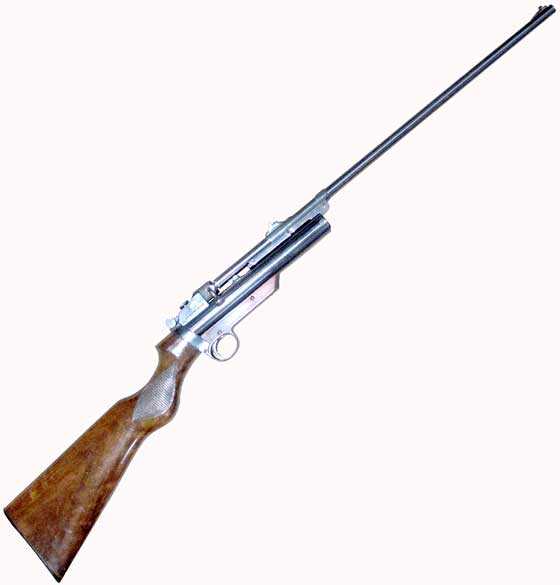
Webley’s Mark II Service air rifle is a Holy Grail of airgun collecting.
One of the finest ever made
Smith wrote that the Mark II Service rifle was “…unquestionably one of the finest target-type air rifles ever made. I would have to agree with that statement from a build and finish standpoint, but from a target rifle standpoint, I have my doubts. However, that is what we shall discover in this test. For you see I encountered a Mark II Service rifle on the Gun Broker auction website recently and I bid for it and won it.
Until now I have only seen this rifle on display at airgun shows. I’ve never seen one for sale in person, though there are a couple for sale on the internet right now. Be prepared to spend a lot of money — as much as $2,800 for a cased set with three barrels! So, when I saw this one going for what I felt was a reasonable number, I had to try to win it.
My rifle is a .22 caliber that has over 90 percent of the original deep lustrous blue finish remaining. There are random spots of rust on the finish at present, but I am treating them with Ballistol, which will soften and remove them over time. Some of the bluing has converted to patina, which keeps the overall rating from being higher.
Breech
The rifle is a breakbarrel that uses a bolt to draw the barrel back into a fiber seal to seal the breech. My breech seal is well-worn and leaks air when fired. The Mark I rifle used a spring-loaded sliding catch to do the same thing — similar to what the Webley pistols use. It didn’t draw the barrel back into the breech seal. This cammed bolt/breech closure is one of the big improvements in the Mark II.
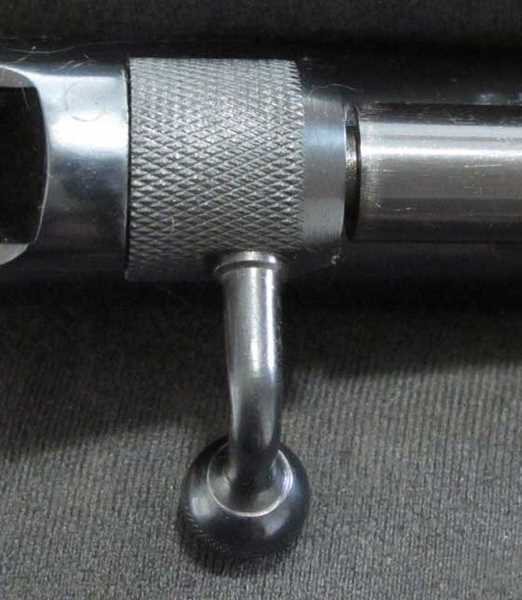
The bolt is closed to seal the breech.
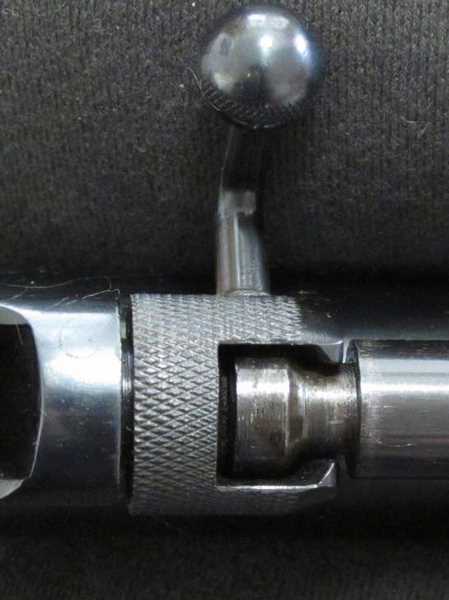
When the bolt opens, the barrel can be lifted out and up for cocking.
Sights
The rifle has both a sporting rear sight that adjusts for elevation alone and a built-in peep sight that adjusts for both windage and elevation. It’s the mark of excellence that strikes you when you first examine the gun.
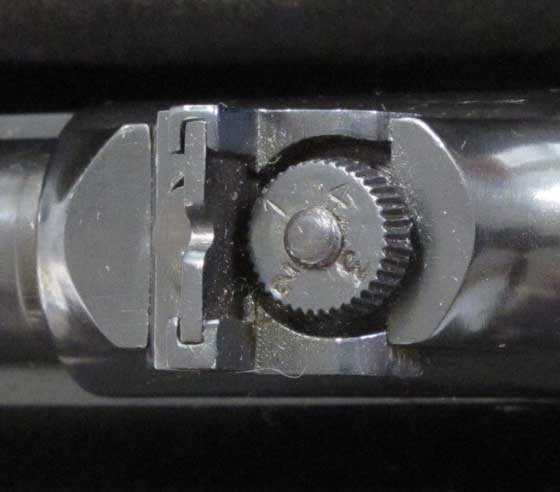
The sporting rear sight has adjustments for elevation. For windage it can be drifted sideways in its dovetail.
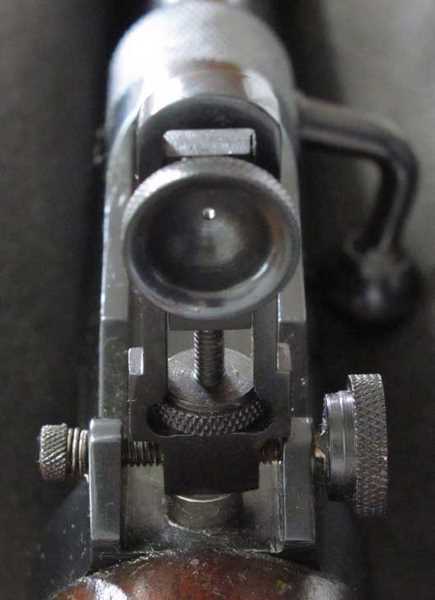
Rear peep sight flips up for target shooting. It adjusts in both directions.
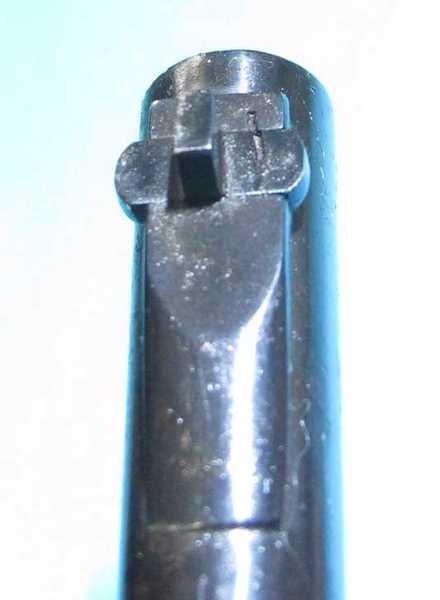
Front sight is a squared post. Notice that it is marked for position on its base and seems to have been moved in its dovetail.
The front sight is a squared-off post in a dovetail. It should be a good target sight.
Large rifle
This is a large air rifle. The overall length is 41.5 inches, which doesn’t seem that long, but the barrel is a stunning 25.5 inches long! The pull is 14-9/16-inches, which puts it into the large category. The rifle weighs one ounce under 7 lbs., which doesn’t sound heavy for a large air rifle, but when you consider that there is no forearm to hold — only a thin receiver bottom — it does seem heavier.
Stock
Yes, there is no forearm. There is only a buttstock, which means that the attachment is via a long through-bolt hidden under the butt-plate. Such attachments either work or they don’t and the buttstock gets loose. This one seems to work well. The wood is walnut without much figure and is stained a dark brown color. Both grip panels have small patches of checkering that don’t seem to add anything to the grippiness.
What now?
Okay — I now own a Webley Mark II Service air rifle. So what? Back in the 1970s when I first saw this model, it seemed like a rifle to get and shoot, but since then I have had numerous .22-caliber air rifles that werte fantastic shooters. I doubt this one will live up to the best of them. But it’s still a bucket-list item, so keeping it rests more on what it is than on what it can or can’t do. We shall see.
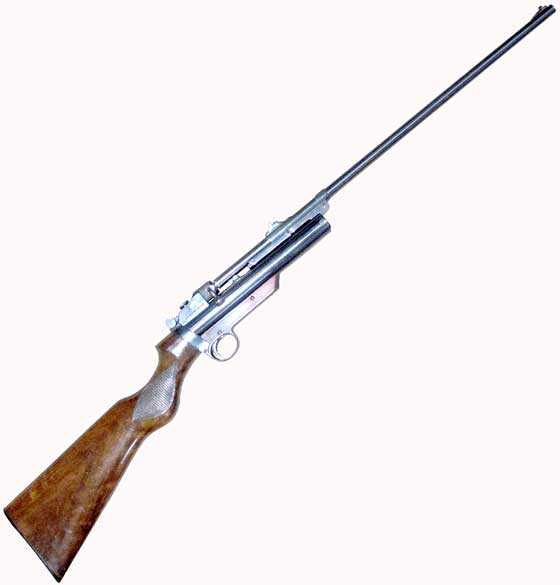
B.B.
Have you yet measured the number of pounds of effort to cock the spring? I was looking for that in your report and didn’t find it.
Charles,
The cocking effort is usually in Part 2, along with the trigger pull.
B.B.
Congratulations on checking off another bucket list item.
Everyone needs to do that.
And start at an early age.
All too soon, we reach a stage where life starts taking more things from us than it gives us.
Enjoy it for what it is, whether it meets your expectations or not.
All though, I have found that sometimes WANTING something,
sometimes is more pleasurable than actually HAVING it.
But that may just be me.
45Bravo,
I think you’re right. Sometimes wanting things is better than having them. Tractors and motorcycles are in that category for me.
B,B,
B.B.,
For me it’s boats. A man’s happiest day is the day he buys his boat; his second happiest day is the day he sells it.
Michael
“Sometimes wanting things is better than having them.” What a wonderful, true statement. As I start to admit that I am becoming a senior citizen, I need to start being more careful about what I have, and just enjoy the “wants” more!
Congratulations on your acquisition! I hope it will hold it’s own! With the sights on this one I believe it should do well!
Reb,
You ok? Folks are asking about you. See over here; /blog/2016/07/beeman-double-barrel-air-rifle-part-1/#comment-383696
Hope all is well.
Mike
Looking forward to more on the Webley MK11 Service, L Wesley in his book Air-Guns & Air-Pistols
makes no mention of any military application, I note that the piston has a metal piston ring.
I’m so jealous. Been looking for one of these for a long time…
Boy, turn your back for just a minute to romance the Countess and polish up the Ferrari and look what happens.
Well, maybe next time…
(Dang it!)
David,
Yes, you don’t want to take your eye off the playing field for a moment. Just the other day I was pondering some gold coins in my collection and missed the opportunity to purchase a 32-foot Chris Craft mahogany triple cockpit speedboat from 1937. Would have been just the ticket for the lake at my summer house! Oh, well! 😉
B.B.
At first glance I couldn’t figure out how it cocked but after reading the article it seems that the engineers upsized the Webley Senior powerplant and then added a longer barrel to boot.
Spelling Errors in the article:
Bucket list 4th sentence: “I was living at Ft. Knox, Kentucky and bought a Webley Senior air pisytol at a local gun show around the same time.” should be, “I was living at Ft. Knox, Kentucky and bought a Webley Senior air pistol at a local gun show around the same time.”
One of the finest ever made
1st sentence: “Smith wrote that the Mark II Servive rifle was “…unquestionably one of the finest target-type air rifles ever made.” should be, “Smith wrote that the Mark II Service rifle was “…unquestionably one of the finest target-type air rifles ever made.”
Last sentence: “Some of the bluing has converted to patina, which keeps the overall rasting from being higher.” should be, “Some of the bluing has converted to patina, which keeps the overall rusting from being higher.”
Siraniko,
Thanks for the heads-up. I fixed both of those entries. The last word was rating, not rusting. 😉
B.B.
So, this must be the Air Rifle I didn’t talk you into getting … but, possibly made you feel better for trying to.
Quite a find. An intriguing metal work of art from days gone by, just like an old Harley Knuckle Head. I’m sure the pride of ownership and joy of shooting it will far out way the money spent to acquire it and any shortcomings it may have compared to todays products.
Now I really like the bucket list thing. I figure at our age we can use that term for just about every extravagant thing we do from now on, and … get away with it !
AWESOME!!!!
If I recall correctly, Mike had several Webley Mark I’s for sale the day I bought my 1906 BSA. I seriously doubt that it will be as accurate as your FWB 300 or other modern competition air rifles, but that will mostly be due to the trigger. With the right pellet and practice I do believe that Webley will give the others a good run for their money.
If you spend a little time with that old girl, she will likely show you she still remembers how to dance. That is why my BSA is still my favorite air rifle to shoot. Quite a few people were surprised and impressed by what I could do with her at the GTA Fun Shoot this year.
In all sincerity, should you decide this rifle needs a new home, please let me know. I think she would get along right well with my BSA.
B.B,
As this rifle is a break-barrel and has both a rear sporting sight and rear peep sight, I have a question. I understand why an aperture sight must be close to the shooter’s eye, and I also understand why the rear sporting sight of a break-barrel must be in the barrel. Why is the placing of an aperture sight well back from the barrel of a break-barrel O.K.? For that matter, why is it O.K. to put a scope aft of the barrel on a break-barrel?
Michael
Michael,
You may have just suggested a topic for me to write about. The reason I have never written about it before is because it is extremely confusing to some people who need to see things graphically to understand them.
The answer to your question is that sights are references. Most people think that when you sight on a target the bullet/pellet goes straight to the target. It doesn’t. It travels along a curved path called a trajectory. Sights are used to align the axis of the barrel, so the trajectory will intersect with the target.
Artillery pieces and mortars have sights, too, but they never look at their targets. Instead, they look at some known fixed point as a reference. When the angle of the tube is changed to change the trajectory, you don’t re-sight on the target — you re-sight on the reference point — typically stakes driven into the ground a few yards (20-40 yards for 4.2-inch mortars) from the gun tube. The farther away, the more precise the “aiming” (adjustments to the known reference) will be. It’s the same thing as having the front sight farther away from the rear sight.
Confused? 🙂
B.B.
B.B.,
I think I understand what you have written above. But perhaps I do not actually understand, because I am still left wondering along these lines of reasoning: Break-barrels, unlike fixed barrels, do not return to the exact same position relative to anything behind the breech from shot to shot; therefore, the rear sight must be forward of the breech, on the barrel, so that its relationship to the front sight does not change. But the line between a peep sight, far behind the break-barrlel’s pivot, changes ever so slightly for each shot, altering the trajectory. No?
Michael
Michael,
No, no NO!
Breakbarrels DO return to the same place — every time. That’s why they can be so accurate.
Some have sloppy breech lockups that wobble, but the good ones are solid.
B.B.
B.B.,
Now I’m REALLY confused. (Smiley Face) Why then are rear sporting sights on break-barrels ahead of the pivot joint?
The more one learns, the more he realizes how vast is his ignorance.
Michael
Michael,
That cancels droop. It has little to do with accuracy or repeatability. That’s why breakbarrel target rifles have their peeps at the rear.
B.B.
B.B.,
That makes perfect sense. Well, I can’t blame that brain lapse on too much Memorial Day weekend indulgence, as I avoided beer completely (trying hard to lose weight).
My eyes are quickly getting to the point that I will soon need to scope everything anyway (with drooper mounts when necessary).
Thanks for setting me straight,
Michael
BB
Kind of related. For very precise shooting why don’t people put a receiver type peep sight behind a scope to make sure the eye is in the same position every shot? Perhaps an aperture actually mounted just behind the rear lens? Thank you.
Fido3030
Fido3030
You must of missed a exspeiment I mentioned to Chris USA to try.
Take a air rifle with a scope. Rest the gun on a bench rest or bi-pods. Then hold the butt of the stock in your hand at the recoil pad. Hold your head at the back of the stock but don’t rest your face on the gun. Find the reticle then place it on your target. As long ng as you hold the reticle on the target you will hit.
I have held my head way to one side or the other where I cold verily see the reticle. Even held my head way high or way low. It doesn’t matter where I have my head as long as I can see the reticle and place it on the target.
I encourage everybody to try it with their scoped rifle. You can even shoot good groups that way as long as you can gold the reticle on target.
Sorry, I did miss it. Thank you.
Fido3030
Fido3030
I was surprised when I tryed. I always thought cheek weld and line of sight placement was important.
What’s important is how steady you can hold the reticle on the target and how well you can repeat the the reticle placement on the target.
That’s what helps make tight groups.
Fido3030,
That sounds like it would get in the way to me.
B.B.
BB
Thank you for your reply. Maybe a small hole in a lens cover? I don’t know much about scopes, just that I’ve had problems with parallax.
Fido3030
Fido3030
Just curious what kind of problems with parallax on scopes?
Gunfun1
I hope I’m using the right term. If my eye is in a little different position point of impact changes a little. Is that parallax? I would get two shots touching and the next two also touching a half an inch away.
It’s been a while and a leapers scope that adjusts down to 5 meters seemed to be better
I’m now using peep sights of various kinds and am very happy
with the results.
I hope this makes sense. I’ve read a lot of BB’s posts on the subject but there’s a lot i don’t know.
Fido3030
Fido3030
Parallax is how a scope focus’ at a given distance.
When you have a scope with the a adjustable parallax on the front objective lens or on a side wheel that is a way to range find. If the scope us in focus at that distance then you should be able to have a pretty good estimate of how far your target is away. And that is usually done with your scope magnification set at a higher magnification. The higher magnification shows the out of focus more. When you turn the adjustment and get the scope focused good then you know that distance. But if you want to be exact you physically measure that distance and add tape to your adjustment knob and write the exact distance down.
That’s part of how the feild target shooters can hit ridiculously small targets at different distances.
Thank you
Fido3030
Fido3030
Yep.
Gunfun1
I’m sorry but I’m confused (not unusual). I just reread BB’s Blog for Oct. 11, 2005 about parallax. Could you possibly take a look at it. I’m missing something. Thanks for all your help!
Fido3030
Fido3030
I read BB’s report.
All I can say is try the experment I explained and you will see you can still shoot good groups.
Can’t say anything else but to try it.
Cheek weld with a scope is not important. Holding the reticle on target is.
Done it over and over and same results. I shoot good groups.
Gunfun1
Thanks for your patience!
I’m in the midst of some other experiments right now, but will try it. Trying things is how we advance.
Cordially, Fido3030
Fido3030,
Try it and see.
B.B.
BB
Thank you, I will. Thanks for all the help and patience.
Fido3030
BB
I took an inexpensive scope, cut an 3/8 inch off-centered hole in the end cap and shot groups with the hole in different positions, though i could see the crosshairs in each position The groups didn’t seem to move. So much for my bright idea.
Fido3030
Fido3030,
Well, now we know.
Thanks,
B.B.
BB
Your gun only has the .22 caliber right?
If so I wish you had the other barrels too. I would like to see how the velocity changed by switching calibers with the same powerplant.
I remember you having another gun that is a springer that the barrels interchange but can’t remember the name of the gun. I think it was a Wiscomb??? I think you did a velocity and accuracy test with it.
But did the gun like you have today do good in all calibers? And what’s interesting is you said the guns were made in the late 70’s. And they had that .25 caliber barrel available. I didn’t think there was .25 calibers back then. Thought most in that time frame was .177, .20 and .22 caliber.
GF1,
I wish I had the other barrels, too.
Perhaps the .25 was a little slow, but the .177 and .22 were good for the time.
Yes, my Whiscombe has all 4 smallbore calibers.
Made in the 1930s — not the ’70s. I first learned about one in the ’70s!
B.B.
BB
Do you think in the next part you could show how the barrel is removed and attached.
And also wondered if it trys to work loose. That Winchester semi-auto .22 rimfire rifle I have needs the spin coller tightened up from time to time. I can tell right away when accuracy starts changing.
GF1,
I plan to do that. I’ll hold all discussion until I show how it works.
B.B.
BB
That’s fine. Was hoping you would show that.
And just wanted to say thanks to all the people that have served in the forces on this Memorial day.
BB,
Speaking of removing the barrel, what insures the barrel returns to the same position should you remove it? As far as I can tell the front sight is attached to the barrel while the rear sight is attached to the barrel mount. Is the barrel keyed?
RR
Oh you didn’t read BB’s comment to me.
He’s not going to continue discussion about the barrel being changed.
You got to wait till the next report.
But it’s BB’s blog. I guess he could change his rules and discuss it now.
RR,
I guess I will have a lot to say about the barrel inn the next report.
B.B.
Fido3030,
Parallax is an angular separation between something that is near and something that is far. When you drive down a country road, the telephone poles next to the car seem to pas by fast, but on a parallel road a quarter mile away the same poles don’t seem to move as fast. That’s because at the greater distance, their angular movement seems smaller. Jet airplanes flying high in the sky seem to move very slow. When they come close to the earth they speed up. That’s parallax.
Parallax is not focus, but is does coincide with focus, because when a scope is focused at a certain distance, the angle of parallax error (between the reticle and the target) is the smallest it can be.
Yes, you can hold your head anywhere on the stock and still shoot a half-inch group, but by holding your eye at the same place every time that group can become a quarter-inch — if the rifle is capable of that kind of accuracy. Parallax only matters in cases were the rifle is capable of extreme accuracy. That’s why it is so important to field target shooters. They don’t want to be off by as much as half a pellet’s diameter.
B.B.
BB
Got to disagree with that logic.
Clamp a rifle in a vise. Get the gun set up so you can look through the scope and the reticle is placed on the target. Let’s say at 25 yards. And make sure the scope is in focus.
Now if you hold your head at the back of the gun stock and find the reticle and it is placed on the target you will hit. And continue to do so unless the gun is moved and the reticle does not point in the same exact spot it was in.
What changes if you don’t repeat your sight picture is you are not holding the reticle exactly the same. The cheek weld is helping you stabilize the gun.
How can the laser on my Talon SS hit every shot when I place it on the target no matter how I hold the gun.
Now take a scope compared to a dot sight like our Tasco red dots. You do have to place your cheek weld and hold the same. That’s why I think people have problems with dot sights on a gun.
If you don’t believe me about the scope. Try it. It’s all about how well you keep your hold the same and how well you place the reticle on target and repeat yourself. Looking through the scope at a angle has nothing to do with groups.
And pay attention the next time you look through your scope on a AirForce rifle. And you tell me if you have your line of sight in a true straight line to the scope. So my think so.
Last sentence is suppose to say. So don’t think so.
BB
Thank you for your reply. But wouldn’t a rear lens cap or other device with with a small centered hole force the eye to always look through the scope in the same way and give better accuracy?
(Talking only about precision shooting, not hunting etc.) just asking, I really don’t know
(GF, I will try your experiment ).
Thank you, Cordially,
Fido3030
@Gunfun1
I have a Benjamin Phoenix NP2 – with the entry level single power scope without AO. If I try your test and move my head around I can see the crosshairs move around the bullseye a bit. I’m not sure what my scope is set to from the factory but I do most of my shooting at 20-25 yards and I have to turn the focus eyepiece out about 6 turns to get it to focus that close … so I’m guessing the scope is set to 50 yards or so. For my cheap scope, it really is important for me to get my cheek and eye in the same spot every time.
AndyPanda
Really important to get your sight in the right place. Or really important to see the reticle and get it in the right place when you make the shot?
Andy Panda,
The eye piece, or ocular lens, is to be adjusted so that the cross-hairs are in focus and not fuzzy. That is the (only) time you should adjust that and once done, you should never have to do it again.
Aim at a white wall, ignore how the picture looks. Look (only) at the cross hairs. Adjust as needed until they are clear and crisp. Lock it down, if it has a lock, and you are done. Another person might require a slightly different setting.
AndyPanda,
You are seeing the effect of parallax.
B.B.
B.B.
That Webley looks like a great piece to own! Congrats!
My grandfather died back in ’68 and I inherited his Remington model 12 pump action .22 … it was well used (my father and uncles and older brothers all learned to shoot on that rifle) and had probably never been cleaned in 60 years. It was always hanging on a nail by the back door at his house.
I had a great time repairing/refinishing the cracked stock and fixing up a few broken bits in the action. It was a lot of fun to shoot but the chamber was so worn/corroded that hi velocity cartridges wouldn’t eject and need to be pried out. I found a few bricks of standard velocity .22 and those worked great. When I was older and had some $ to spend, I took it to a gunsmith who pressed a new rifled sleeve into the barrel – I’m not sure if that is the best thing I could have done but I don’t think those guns had any big collector value and this one had been ridden hard and put away wet. It shoots fantastic now with the fresh barrel and always brings me a lot of joy to shoot.
My eyes are getting old and it’s hard for me to use iron sights – I can choose to focus on the sights and not be able to see the target or focus on the target and not be able to see the sights 🙁
So I have a red dot sight on my old Colteer semi auto .22 rifle – really works great for my eyes as the dot appears to be (and focuses) out where the target is. Not sure if I want to modify the old Remington 12 to take a dot sight or not. (and besides, it’s so hard to even buy rimfire ammo – I’m more interested in air guns now)
Gunfun1
I’m no expert – by a long shot – but from what I’ve been reading with google searches …. Parallax error is what I’m seeing. I may have this wrong – but I though that Parallax needs to be set for the distance you are from the target and if it is set right, THEN you can move your eye side to side and the reticle will stay on the target.
But mine doesn’t have adjustable parallax and I have no idea where it’s set – but because the focus seemed to be set to 50 yards, I’m guessing the parallax is also factory set to 50 yards … and I’m shooting at 20 yards so the parallax being off is why I see the reticle move to either side of the bullseye when I shift my eye left to right on the scope.
AndyPanda
Hmm. I can leave my scope set at 50 yards parallax or 100 yard parralax and do the experiment I mentioned. And yes the reticle will move around.
But here is the magic. If I can put that reticle on my target I will hit the target. If I move my head to the other side of the gun yes the reticle will move. But again the magic. If I place the reticle on the target I will hit.
It’s as I said. How well I place the reticle on the target determines how well I hit. And as far as what we want to call it. If the reticle shifts then that’s called parralax ok. But I associate distance focus as parralax.
Hi BB,
I enjoyed this blog. I wouldn’t say that the Webley Mk 2 is on my bucket list but it is very neat. Arnold Smith had one with at least 2 barrels at Malvern several years ago. He took the time to show me how it worked. It is very cleverly made.
My bucket list is pretty expensive: A Girindoni repeater, a Giffard C02 Rifle, and an Air Cane. This is not a list of items I have any intention of really buying but are things I wish I could experience.
David Enoch
I’m anxiously awaiting my very first Webley air gun. They certainly have a reputation for quality. I’ve never actually seen one in person or handled one, so I am hopeful that the one I receive will be up to the standards of their company. Of course the one I ordered is a Tempest pistol that is made in Turkey, not in the UK so I really am just getting their design. Either way I love reading your blog and learn something new every time you post. Thank you for sharing your vast experience and knowledge.
I have also been readying your articles about tuning a spring piston air rifle and have decided it is probably best that I do not attempt to do this myself. Do you have a list of people that do this sort of thing? If you could point me in the right direction I would appreciate it very much. By the way I am in Nashville Tennessee if that means anything, maybe there is an air gun expert tuner close by?
Docteur Ralph,
I recommend you contact Dave Slade. Dave is a Brit who has moved to the States. He has a lot of experience with spring guns.
Find him here:
http://www.airgunwerks.com/index.html
B.B.
Oh and Happy New Year!
Hi there,
I’ve been reading your blog with great interest, and I must commend you for your knowledge and the great detail that you go into.
I was brought up on a small farm and my father owned various guns at the time including an air rifle which I got to use for target practice.
When my father passed away a few years ago I got the appropriate licences to keep the shotguns and the .22 Remington for sentimental reasons mainly and my brother was given the air rifle.
As of this year you now need to apply for a licence for owning an air rifle and my brother was not going to do this, so I took the air rifle and got the licence for it, again mainly for sentimental reasons as all the guns had belonged to my grandfather as well.
Lately I’ve tried to find out a bit more about the air gun and that’s what brought me to this page on your blog, as the gun is a WEBLEY SERVICE AIR RIFLE MARK II .
I thought the gun was old but did not think it was this old and that it was held in such high regard, so as you can imagine I am now one happy owner.
The gun is not in as good condition as the one you show, mainly down to age, nothing broken or marked and it still fires well.
It has the .177 barrel and I have what I think is the original case with space for 2 barrels.
I was wondering if it is possible to give an accurate age of the gun.
I’m also wondering if it is worth trying to restore the original bluing or is it best left alone as I think you said somewhere. I also noticed that you are buying another barrel do you think it would add anything to the collectability of the gun if I did likewise, if it is possible to post photos I would do gladly.
Many thanks for your blog ,
One happy air gun owner.
Highland loon,
Welcome to the blog.
I would leave the bluing as it is, unless it is a horrid mess. Rebluing means buffing and once that is done the gun loses a lot of collector value.
Given that you have an original case I do believe adding one or both of the other two barrels would add value.
We don’t have a way to post photos to this blog in the comments section. What people do is post them on a public photo sharing site, then post the links to them in the comments.
You do have a wonderful air rifle and I can tell that you appreciate it. Well done!
B.B.